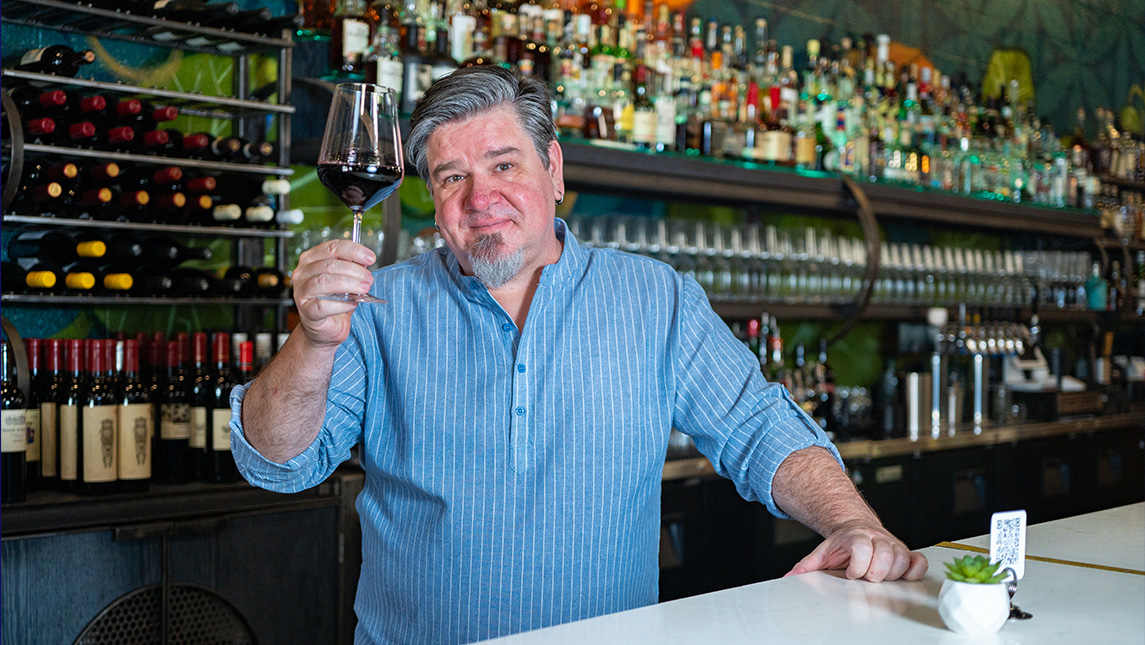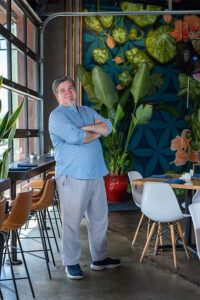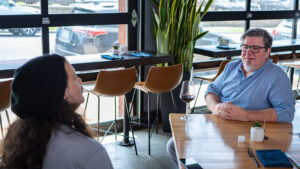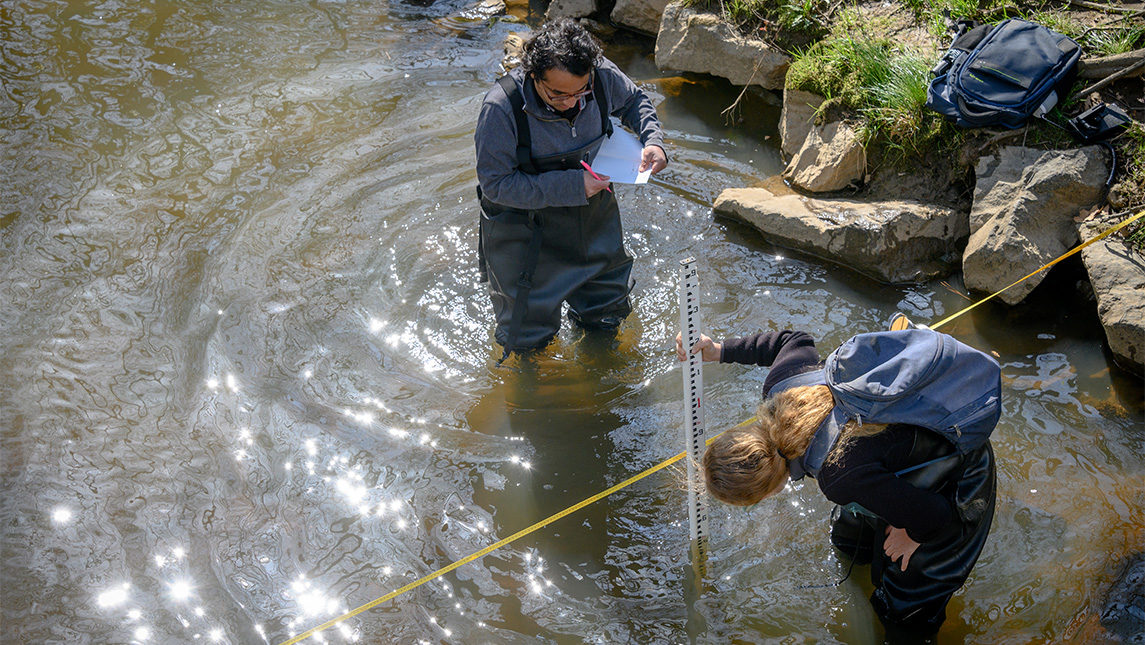
Hit restaurant visionary, video game consultant, world traveler, and Greensboro enthusiast — that’s Tal Blevins ’95
In 1990, he had his choice of North Carolina schools to attend — UNC Chapel Hill, Wake Forest, etc. — but he decided to go with UNC Greensboro. He wanted a medium-sized environment and, as he says: “I was familiar with the campus and just thought it was really pretty, and I wanted to go to, you know, not a big ‘mega school.’’’
The 2022 James Beard Foundation semifinalist and owner of one of the top 20 Yelp-reviewed restaurants in the country started out at UNCG as a…computer science major? But Blevins ended up in the Department of Geography (as it was then called), where he enjoyed taking urban planning courses with Dr. Keith Debbage. After UNCG, he went on to a master’s degree in urban planning from the University of Georgia.
“And then I went into tech and video game journalism, and then I opened a restaurant. The classic track,” he jokes. But there is a relationship.
“I always thought of geography as modern-day anthropology of why humans are doing things today in the present day. That’s what interests me about urban planning and city morphology — how people organize themselves around urban areas. It’s all about spatial relationships, you know — NIMBY, “not in my backyard,” two-minds policy and everything. So, that’s why geography to me was an all-encompassing science. And it also includes human psychology as well.”
But how does all that relate to tech journalism — Blevins’ bread and butter for 20 years, in San Francisco and worldwide, covering technology, pop culture, video games, movies, and more.
“So, I was a writer, and I’d say the thing my educational career, more than anything, helped me with for the next phase of my actual career, was the writing portion. Being a journalist, regardless of what beat you’re covering, you’re writing all the time — it’s a 24/7 kind of job. So, through my education I learned how to create stories and create messages.
But fast forward 20 years.
“That certainly helped me with marketing and getting the word out about Machete,” he says. “So, really, that’s tied to everything that I’ve ever done in my life. I’ve been a storywriter, story creator, content creator, and I love to create environments, experiences, and emotion around experiences.”
The story of Machete’s lift off wasn’t a normal one.
Blevins, as a restauranteur, came out of the supper club and pop-up restaurant scene in San Francisco. He had met people who hosted them, and chefs who prepared the meals in all kinds of spaces that weren’t traditional restaurants.
When another Greensboro restaurant that Blevins loved had closed, he reached out to their chefs, who were considering moving out of the area to do the type of food they wanted to do.
“And I said, ‘No, no — we need your food here. Why don’t we do some of the things that I saw happen in the pop-up restaurant, pop up dinner club supper club scene on the West coast? And we started that out of my house, and we did that for a couple of years. And it was great, because it was just friends and family at first — 12 people a month. And then we had to expand. Within a couple of months, we had up to 20, because more people wanted to get in. And then, you know — word of mouth, friends of friends, or friends of friends of friends. We had to do two nights back-to-back every month. And we were doing 40 a month and we had about 200 people wanting to get seats for what we were doing.”
“So, that was also creating that story,” says Blevins. “We use a lot of social media channels, especially Instagram and Facebook, to get the word out. But also, just the verbal story being told, you know, word of mouth. The dream was always to have a full-service restaurant, we kind of wanted to test the market, and then be able to do it.”
What’s the story behind the name?

We were sitting on my back porch in Westerwood, and we were talking about names. We had maybe a couple dozen names. And Chef Kevin told a story about how when he was a kid growing up in Oak Ridge. He had lot of woods behind his house. And his favorite “toy” when he was 12 years old or so was a machete he’d take in the woods. He’d go out and hack up trails and play in the woods all day long. And he said he always wanted a restaurant called “Machete.” That was so poignant to me, because we had always liked very modern food, but we also like to call back to childhood flavors. I always like to tell people “Machete” is because we’re cutting edge and we’re carving a new path here in Greensboro, but it also comes from our chef’s childhood memory.
What was it like opening the restaurant during COVID?
We opened up the restaurant three weeks before COVID. That was a journey, to say the least. Obviously, you plan these things out. We had that vision locked down for six to nine months before we actually opened up, of what we wanted out of the restaurant. And, with the food we prepare, it’s so meticulously constructed and put on the plate. It is like eating a work of art. So, that stuff doesn’t translate well to being put into a cardboard to-go container.
In the first three weeks when we opened, we were slammed. We were getting our footing. At the time, we had a smaller staff, because we were just starting up. So, after COVID hit, we probably kept about half the staff, and we started doing takeout. And the takeout really took off. We approached it as: what kind of food would we want right now, if we were stuck at home, and we really thought about, you know, our take on comforting “fast food.” So, we did a great double fried chicken sandwich. We did that polenta and short rib dish, we did a pasta bolognese, which everybody just loved. Of course, for brunch, we did the cinnamon rolls, and those like really blew up. And everybody really liked those, to the point of where we just couldn’t make enough of them.
It was interesting to be able to get through that hump. I owe that credit to is the team being able to adapt very quickly. We realized that weekend of the ACC tournament that everything was going to change, when they stopped letting viewers and guests in. And I thought, “Oh, man, that doesn’t bode well, and this seems like it could spell businesses closing down pretty soon.” So, we got together on Monday and said, “Hey, what do we look like if we’re at this before anything comes down from the governor? But what do we look like as a take away restaurant?”
We were able to come up with a menu in 24 hours. In anticipation, we ordered all the cardboard material we’d need, anything to package and go. I think that’s honestly what saved us — just being as fast and quick on the draw as we were, and being able to pivot quickly, in a very strange, unprecedented situation. I really credit the staff and us thinking about executing quickly to get that going, because we probably would not be around if we had not done that.
Since we were the last restaurant to open up in this area before COVID, we weren’t eligible for any of the government funds. They all look back to revenue at 2019. It was the community that kept us afloat. And we’re just so thankful.
To see where we are today, getting a young Top 20 in the country, getting the James Beard Award nomination, that’s just overwhelmingly crazy. It justifies our decision to open and the way we stayed open. We get comments that our style of food reminds them of an experience they had in Chicago or DC or New York or San Francisco, and now they can get it in their own backyard. And we’re staying busy, so, thanks, Greensboro.
Tell us about the Machete vibe.
We are a modern, small plate restaurant focusing on global flavors. Like I always say, “We’re a farm to table restaurant. But that farm may be in Argentina.” Although we do use a lot of local protein and produce and seafood — we got such great stuff here in North Carolina — if there’s a product that only comes out of Japan, then we’re going to get that as well. And we’re going to mix a lot of different global flavors together. We’ve got our take on a beef rib right now — everybody’s familiar with beef ribs around here, but we do it with the chimichurri sauce as well. We like to add a lot of those different flavors from around the world. There’s a watermelon dish that we have right now where we do a compressed watermelon and ponzu and seaweed. There’s a tomato dish that we’re making with parmesan foam. And we’re making these little tomato caviars that just melt in your mouth, since it’s tomato season right now. It’s hard to beat North Carolina tomatoes. It’s very pretty artful plating — very much “art on a plate.” And we do our cocktails the same way — we want you to always eat with your eyes first.
How did your interest in food and restaurants start?
My interest in food and restaurants started when I was five years old. My granddad loved food, and I was introduced to things I wasn’t “supposed to” like. So, my favorite meal as a kid was spinach, squash, and calf liver. And I would order it at the diner. My mom would tell me the story of how the waiter would say, “Are you sure? Does he really want this?” And my mom would say “He doesn’t know he’s not supposed to like that.” I’ve always been interested in flavors. And with my tech job, I was able to travel all over the world — to Asia, all over Europe, all over America and Canada. I always wanted to try local restaurants, local independent restaurants. Because to me, the experience and texture and everything that you get in a good dining experience is one of the best experiences of life. It’s one of the great pleasures of life. And that goes for you know, high end fine dining and, say, Thai street food. Some of my favorite food is in Thailand at some of the street food stalls there — some of the best food I’ve ever had in my life.
Favorite food?

Japanese flavors. I love Japanese and just Asian flavors in general, but I think Japanese cuisine is simple perfection. Most sauces are a combination of four or five ingredients in different ratios. If you can nail something that tastes so good but uses so few ingredients, then that’s mastering the technique. I love Japanese skewers and beer. Every time I’ve visited Japan, it’s so different than what we’re used to in the United States. I love going to Tokyo and then, outside of Tokyo, Kyoto is probably one of my favorite cities in the world. It’s beautiful, and a great mix of like the old and the new.
About video games…
I still run a video game consultancy. We work with publishers and developers of video games. I was in that world for 20 years as a journalist, so we give publishers and developers some outside perspective on their products while they’re still in development. Because when you’re working on these projects, it may take four to five years, or even longer, for some video games to develop. They may understand all the systems and mechanics, but we give them perspective on “What’s your marketing message on this? Is that going to play well with what consumers would like?” We give them advice when they go to a convention.
Favorite video game?
My favorite video game of all time is probably “Ultima Underworld,” which dates me — that’s an old game. It was the first 3D game on home computers, basically a digital representation of “Dungeons and Dragon.” So, fantasy 3D, where you could actually look around the environment. That just blew my mind at the time because before that, games had just been very “flat.” You know, running left and right. And that’s about it. So, to be able to walk around in this dungeon was just incredible.
Favorite other piece of technology?
I collect too many guitars. I love guitars. So, probably just musical stuff in general. Anything that can make a noise or that you can create music with. When I was at Weaver Center, electronic music was one of my favorite classes. I’ve always been into key keyboards, drum machines, but also analog. VR also blows my mind. I think it’s kind of like “Ultima Underworld,” when I can be transported to an entirely different space that feels like it’s actually there. It’s such a transformative technology.
What’s your current impression of UNCG and of Greensboro?
I still love the feel of the campus. I love how inclusive the campus is, and how inclusive the student body always has been. I mean, when I was there in the 90s, you always saw a good mix of ethnicities, genders, and backgrounds. I’ve always felt UNCG has been one of the more diverse university campuses that I’ve set foot on.
I helped with the eSports program because of my background in tech and video games. I helped develop two courses — “Athletic Content and Viewer Engagement” and “Hype, Engagement, and Sponsorship.”
I’m excited about the future of Greensboro. When we first moved back to North Carolina, I thought we were probably going to end up in Raleigh, but I just didn’t get the sense of community and neighborhood that we got in Greensboro. So, we just kept coming back and we really liked the feel of Greensboro. There’s a lot of opportunity with Boom Supersonic coming in and the Toyota EV battery plant coming in. It’s like our old moniker “the Gate City.” It’s the perfect place for where we are in technology, a perfect hub.
Story and interview by Susan Kirby-Smith, University Communications
Photography by David Row, University Communications

Connect geography with humanity
Geography has always been about thinking across boundaries. Our vision for the UNCG Department of Geography, Environment, and Sustainability reflects its historical strengths at the intersection of environment, human geography, and geographic technologies, and it reflects a desire to have our teaching and research strive for a better world.


